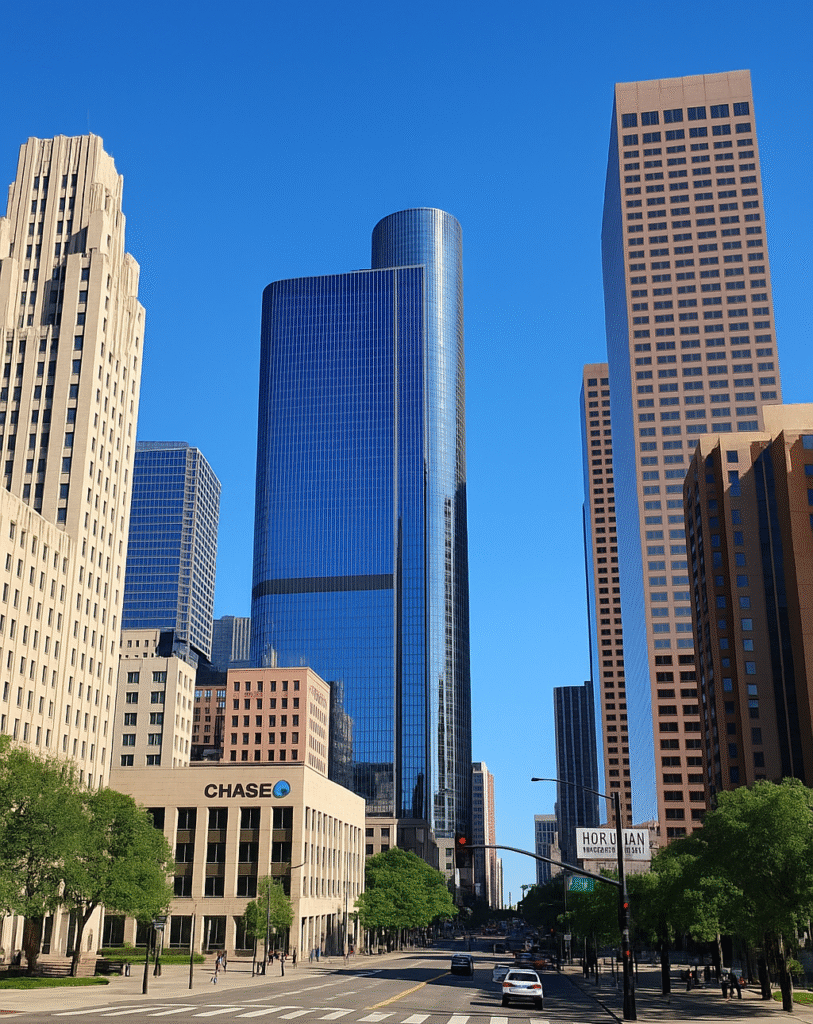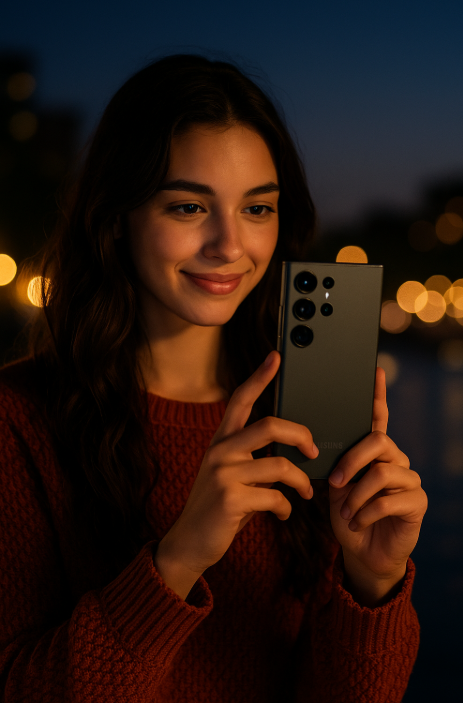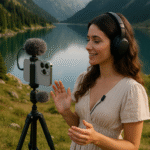I’ve personally used the Samsung Galaxy S25 Ultra camera for two months now, and I can confidently say this: its system has officially taken the spotlight in 2025. As someone who’s always been a content creator and a night shooter, I was curious to see if this flagship would finally capture more shadows by striking in log video and whether its AI would zoom pics to 100x.
Well, as you read this review, know that I’ve explored facts on how the S25 Ultra camera performs across real-world scenarios, especially in low-light photography, color accuracy, and consistent exposure.
Camera Hardware Overview
Let me break down the Samsung Galaxy S25 Ultra camera specs packed into this high-end smartphone.
The flagship has 4 rear cameras and one front camera which include
The primary 200MP wide Angle-lens built on a full 1-inch sensor and a 24mm equivalent of an f/1.7-aperture lens. It uses multi-directional PDAF and an Optical Image Stabilization to enhance its image clarity. The camera also features a 2x Optical Quality Zoom (which is honestly impressive for a phone), and Samsung has also included an AI ProVisual Engine that actually improves color and details in real-world shooting.
The 50MP ultra-wide camera is an upgrade that comes with a 120° f/1.9 aperture lens and dual-pixel PDAF for precise macro shots. Finally! You can now reveal every detail of the tiny world around you.
Samsung also included the following dual telephoto lenses:
The 50MP Telephoto with 5x Optical Zoom and 10x Optical Zoom Quality. It has a lens with a 1/2.52-inch sensor that is equivalent to 111 mm and an F3.4 aperture of a periscope design. It also uses PDAF and an enhanced OIS so you can clearly feel the difference when shooting handheld

The other telephoto is the 10MP tele, which features a 3x Optical Zoom and a lens with a 1/3.52-inch full sensor equivalent to 67mm and an f/2.4-aperture lens. Again, it uses PDAF with an improved OIS.
The 12MP front camera is your perfect selfie lens, which uses a F2.2 aperture and dual-pixel autofocus technology.
The AI Image Engine 3.0 is Samsung’s latest attempt at computational photography, and honestly, it’s less heavy-handed than previous versions. Your photos actually look natural and clear.
Global Ranking
The Galaxy S25 Ultra ranks 26th globally in camera performance, which is a solid showing but not groundbreaking. Samsung actually made two key hardware upgrades: the Snapdragon 8 Elite chipset (up from 8 Gen 2) and a 50MP ultra-wide camera (previously 12MP). Everything else remains largely unchanged from the S24 Ultra.
I tested the phone across multiple software updates, but despite Samsung’s software tweaks and new AI features, the improvements over S24 Ultra model are still minimal.
Performance in Bright Light
I’ll be precise with you: in good lighting, this camera is almost too good. I took it out during golden hour last weekend, and the dynamic range genuinely shocked me. I was shooting at downtown buildings, and somehow both the sky and the shadows in the foreground were perfectly exposed.
The detail retention is remarkable. I zoomed into a photo I took, and I could still read the text on signs three blocks away.

Though you’ll still see a slight shutter delay when you press the button, the camera is faster and more responsive than the S24 Ultra—better for capturing moving subjects.
The shallow depth of field creates nice background blur but can work against you in group shots where some faces might fall out of focus. I also noticed some highlight clipping that reduces detail in the brightest areas. Colors look vivid, and skin tones appear natural in most situations.
Good enough! Close-up portraits look good with natural skin tones and solid exposure showing realistic colors.
Low Light & Night Mode Photography
Last Tuesday, I was at a dimly lit restaurant with some friends. The lighting was terrible—and I decided to test the camera, and I was genuinely shocked by the results.
Low-light performance is mixed. Most shots get proper exposure, but subjects sometimes appear slightly underexposed. The noise reduction is incredible, and detail quality varies between consecutive shots in the same lighting conditions. White balance generally stays accurate, though it can look unnatural under tricky lighting situations—creating unwanted color casts.

The camera delivers good overall results but lacks the consistency you’d want, especially with noise control and exposure accuracy across different lighting conditions. Low-light sharpness did improve slightly compared to the S24 Ultra.
Even at high ISO, the photos looked clean without that over-smoothed, plastic look that usually comes with aggressive noise reduction.
The night mode is faster now too; it captures multiple frames quickly and combines them intelligently. The white balance is actually realistic—warm lighting looks warm, not like everything was shot under fluorescent lights.
The Camera’s Zoom Game: Crisp Even at 30x
I’ll admit, I was skeptical about the zoom capabilities. Most phone zoom features are just fancy cropping, right? Wrong.
The 5x optical zoom is perfect for portraits. I tested it with my daughter, and there’s zero distortion. Her face looks natural, not like she’s been stretched through a funhouse mirror.
The 10x optical zoom is where things get really interesting. I was at a baseball game last weekend, and I could capture clear shots of players. Sure, it’s not DSLR quality, but it’s way better than I expected.

Here’s a pro tip I discovered: when you’re at maximum zoom (30x), the phone’s stabilization really kicks in. It’s almost like having a tiny tripod built into your phone.
Generally, the zoom performance stands out at long telephoto ranges while maintaining a good quality image at closer distances. The upgraded 50MP ultra-wide has a slight difference from the previous generation’s image quality despite the resolution bump.
Video Quality: Stabilized Than Ever
I’m a video person, creating content regularly for my startup, and the S25 Ultra changed my mind. The 8K recording at 30 fps is impressive, but honestly, the 4K at 120 fps is more practical for everyday use.
Furthermore, the auto-framing feature is surprisingly smart. It tracked my kids running around the backyard without me having to constantly adjust the shot. The focus tracking works so well too, and the footage is perfectly clear.

The HDR10+ recording (in the HLG format) is noticeable when you’re shooting in tricky lighting. I recorded a sunset last week, and the colors in the sky were actually visible instead of being blown out.
The Good and the Bad Side
The Galaxy S25 Ultra’s camera system excels with excellent detail capture, versatile zoom capabilities, and new features like LOG video recording and an upgraded ultra-wide sensor. However, we note minimal hardware improvements over its predecessor and occasional performance regressions in exposure and noise handling.
Strengths
Zoom Excellence
- Exceptional detail capture in telephoto shots, particularly at extended ranges
- Reliable image quality across close, medium, and long-range zoom settings
- Strong performance when using the 5x zoom module
Video Capabilities
- Wide dynamic range with well-balanced highlights and shadows in good lighting
- Accurate exposure management in bright conditions
- Natural color reproduction with neutral white balance in well-lit environments
- Effective video stabilization that counters camera shake well
Detail and Texture
- Strong detail preservation in most shooting conditions
- Improved low-light sharpness compared to previous generation
- Fine texture capture with high accuracy in bright light
Portrait Photography
- Natural skin tone rendering in favorable conditions
- Faster shutter response than predecessor, better for moving subjects
- Vibrant colors with generally proper exposure in good lighting
Weaknesses
Noise Issues
- Intrusive grain in high-contrast scenes and low-light situations
- Inconsistent noise reduction between consecutive shots of the same scene
- More pronounced noise problems than the previous model
Exposure Inconsistencies
- Noticeable highlight clipping in bright light conditions
- Occasional subject underexposure in low-light scenarios
- Exposure adaptation can be abrupt during lighting transitions
Color and White Balance
- Color casts appear, especially in challenging lighting conditions
- White balance can look unnatural under difficult illumination
- Slight warm tint and desaturation in low-light video
Autofocus Reliability
- Occasional focus failures in dim conditions
- Sometimes locks onto incorrect subjects in low light
- Focus stepping creates less smooth transitions in video
Low-Light Performance
- Struggles with consistency in dim environments
- More challenging performance in video recording under poor lighting
- Artifacts become visible in darker scenes
The camera delivers solid overall performance but shows some regression in noise control and consistency compared to its predecessor, while maintaining strengths in zoom capabilities and detail
Frequently Asked Questions
Is the S25 Ultra camera good or bad?
The S25 Ultra camera is genuinely one of the best smartphone cameras in 2025. its 200MP main sensor, enhanced AI processing, and excellent low-light performance make it professional-grade. It’s not just good—it’s impressive.
What is the ranking of Samsung S25 Ultra camera?
Based on my experience and what I’ve seen in reviews, the S25 Ultra consistently ranks at position 26th globally, competing directly with the iPhone 16 Pro Max and Google Pixel 9 Pro in the best category of smartphone cameras.
What’s the difference between the S25 Ultra and S24 Ultra cameras?
The main improvements on the S25 Ultra are a larger 1-inch sensor on the main camera, significantly better low-light performance, upgraded AI Image Engine 3.0, and much better zoom stabilization. If you have an S24 Ultra, the upgrade is noticeable but not revolutionary.
How many megapixels does the S25 Ultra camera have?
The main camera is 200 megapixels, the ultra-wide is 50MP, and the telephoto lenses range from 10MP to 50MP depending on which zoom level you’re using.
What’s the peak brightness of the S25 Ultra display?
The screen reaches 2,800 nits peak brightness, which makes it one of the brightest smartphone displays available. It’s genuinely usable in direct sunlight.
Does the S25 Ultra really have 100x zoom?
Yes, it has Samsung’s Space Zoom technology with up to 100x hybrid zoom. However, the sweet spot for actual usable photos is between 10x and 30x. Beyond that, you’re pushing into “digital zoom” territory, where quality drops significantly.
Let me walk you through two comprehensive tables that summarize the S25 Ultra’s camera performance. These tables break down both photo and video capabilities across seven key aspects: exposure, color, contrast, texture, autofocus, noise, and artifacts. If you’re a photography enthusiast or just love capturing moments, this detailed breakdown might just spark your excitement to try out the Galaxy S25 Ultra’s powerful camera for yourself.
Samsung Galaxy S25 Ultra Camera Performance Summary
Photo Performance
| Aspect | Performance Summary |
|---|---|
| Exposure | Accurate target exposure in non-challenging scenes with generally correct brightness levels. HDR processing provides a wide dynamic range, but highlight clipping is more noticeable than its predecessor, especially in challenging lighting conditions. Colors appear more vibrant but occasionally oversaturated. |
| Color | Generally accurate color rendering with neutral white balance in bright light. Natural skin tones in most scenes. But color casts can appear especially in low-light conditions. Colors are best in bright outdoor scenes but can look slightly unnatural due to occasional color casts. |
| Contrast | Excellent dynamic range performance with well-balanced highlights and shadows thanks to HDR capabilities. However, highlight clipping can be noticeable in bright light conditions, and some contrast issues in challenging lighting scenarios. |
| Texture | Good detail preservation in most conditions, particularly improved in low-light compared to the S24 Ultra. Sharpness slightly better than the previous model in low-light conditions. Level of detail comparable to S24 Ultra overall, with some scenes showing better detail retention. |
| Autofocus | Reduced delay between pressing the shutter and capturing the image compared to the S24 Ultra. Autofocus precise and stable across various shooting conditions, particularly improved in high-contrast scenes. In contrast to the previous model, the depth of field is occasionally shallower. |
| Noise | Well controlled in bright light, but more intrusive in strong backlighting and low light conditions. Grain particularly noticeable in high-contrast and low-light scenes. Unpleasant chroma noise and noise reduction instabilities across consecutive shots observed. |
| Artifacts | Overall artifacts managed better than S24 Ultra but less controlled than the competitors like iPhone 16 Pro. Color quantization more noticeable on new model. Various artifacts present but generally well-managed. |
Video Performance
| Aspect | Performance Summary |
|---|---|
| Exposure | Accurate target exposure on faces across various light conditions with well-balanced brightness levels. Wide dynamic range preserving detail in highlights and shadows, but slight highlight clipping in high-contrast scenes. Exposure adaptation can be abrupt when transitioning between lighting conditions. |
| Color | Neutral white balance and accurate color rendering in bright light with natural, well-balanced tones. White balance stable across scenes contributing to color consistency and pleasant skin tones. Slight warm color cast and mild desaturation noticeable in low light. |
| Contrast | Wide dynamic range effectively preserving detail in both highlight and shadow areas. Good balance between bright and dark areas thanks to HDR processing, though some highlight clipping can occur in particularly challenging high-contrast scenes. |
| Texture | Perfect detail capture in bright light, preserving fine textures and intricate details with high accuracy. Well-balanced sharpness providing a natural look without excessive processing. Some artifacts with local floating texture visible in low light affecting overall quality. |
| Autofocus | Responsive and precise autofocus system ensuring accurate focus on faces in bright light. Generally fast autofocus providing sharp, well-defined subjects. Occasional autofocus failures in low light with focus sometimes locking onto the wrong target. Some focus stepping resulting in less smooth transitions. |
| Noise | Well controlled and not noticeable in bright light conditions. More intrusive when recording low-light scenes, appearing stronger than the S24 Ultra. Noise impacts image quality in darker scenes, particularly in plain color areas and shadow portions. |
| Artifacts | Occasional unwanted artifacts, including ringing around high-contrast edges impacting sharpness, aliasing, and moiré. Flare is noticeable but less pronounced than some competitors. Hue shift effect visible near clipped areas and color quantization affecting smoothness of color gradients. |
Should You Buy This Phone for the Camera?
After two months of real-world use, here’s my verdict: if photography is your thing, then the Galaxy S25 Ultra is genuinely worth considering.
The low-light performance alone is worth the upgrade if you’re coming from an older phone. The zoom capabilities are legitimately useful, and the AI processing has finally reached a point where it enhances photos without making them look artificial.
Whether you’re documenting family moments, building a social media presence, or just want to take better photos, the S25 Ultra camera system delivers professional-quality results in a pocket-sized package.
This review is based on two months of real-world use with the Samsung Galaxy S25 Ultra. Your experience may vary depending on your photography style and preferences.


